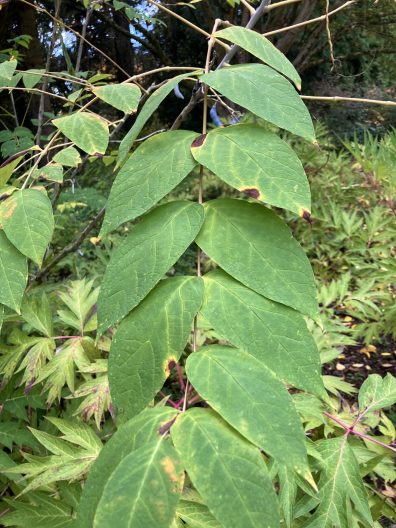October Plant Profile: Decaisnea insignis
 At first glance, Decaisnea insignis isn’t a particularly striking shrub; growing between 10-15 feet high, its pinnately compound leaves arch away from the thick, central branches of the plant. It flowers in June, with long strings of dangling greenish flowers that can be hard to notice, blending with the yellows and greens of the rest of the plant.
At first glance, Decaisnea insignis isn’t a particularly striking shrub; growing between 10-15 feet high, its pinnately compound leaves arch away from the thick, central branches of the plant. It flowers in June, with long strings of dangling greenish flowers that can be hard to notice, blending with the yellows and greens of the rest of the plant.
What does make you look twice at this plant, though, are the fruits that ripen in the fall between September and early November: thick, blueish bean-like pods dangle where the flowers were, giving this plant its common names: Dead Man’s Fingers, or Blue Bean Tree.

Each fruit splits open as it ripens, eventually dropping from the plant as it does so. The skin of the fruit is soft, pebbly, and a little rubbery (surprisingly finger-like); when it splits open, you can see smooth black seeds floating in a pale, gelatinous, pulpy flesh.
The name Dead Man’s Fingers is perhaps a little off-putting, but the pulp of these fruits is actually edible, described as having a sweet, light flavor, and has been enjoyed for centuries by the indigenous Lepcha people in India. Beware, though – Dead Man’s Fingers is this plant’s common name, and it’s a name used for several different plants (and fungi!) that are inedible and – in some cases – poisonous.
Decaisnea insignis is in the Larzdizabalaceae, a family that is also home to vining plants such as Akebia and Stauntonia. It is native to China, Nepal, northeast India, Bhutan, and Myanmar, normally growing between 900 and 3600 meters above sea level. The plants have both male and female flowers, with only the female flowers developing into the striking blue fruits. Here at the Washington Park Arboretum, we have several specimens growing throughout the park, but one of the easiest to find and see is right off Arboretum Drive in Grid 17-4E, not far from where the Magnolia collection grows and planted among several tree peonies. If you visit now, you can still see the blue beans dangling from the midst of the leaves, easily visible from the trail! Another easy to find specimen is in Grid 7-2E along the trail at the border between the New Zealand Forest and a planting of plants native to China in the Pacific Connections Garden.
Resources: